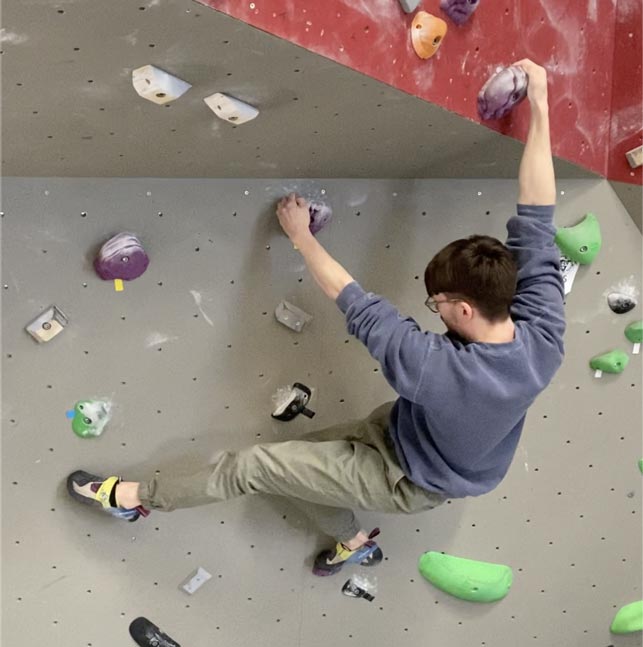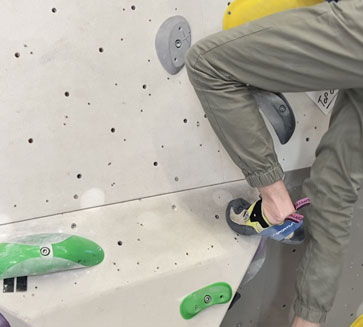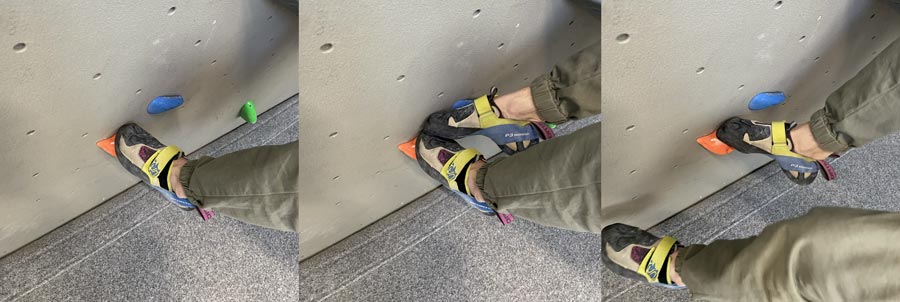Developing good footwork, body positioning, and efficient movement are essential to becoming a more well-rounded climber. Knowing technique is not enough, technique must be trained. Through regular training drills, technical moves can become muscle memory enabling climbers to gradually progress not only on the subjective grading scale but also as efficient climbers.
By incorporating these drills into your warmup routine, you can develop better body awareness, balance, and control on the wall. In this article, we will discuss several technical drills that you can add to your warmup routine to help take your climbing to the next level.
These drills aren’t just for indoor boulderers, they are useful to all types of climbers, but bouldering gyms are best set up for training drills.
📚 This article is part of two wider guides: Climbing Technique 101 & The Basics of Indoor Bouldering
Why do climbers use technical drills?
Climbers use technical drills to improve their climbing skills and technique. Technique drills are used to isolate specific aspects of climbing and focus on improving them through repetitive practice. By practicing drills, climbers can improve their footwork, body positioning, balance, and other technical skills, which can help them climb more efficiently, effectively, and with less effort.
Technical drills are also useful for developing specific climbing styles, such as dynamic or static climbing, and for preparing for different types of climbing challenges, such as slabs or overhangs. By practicing technical drills, climbers can gain the necessary skills, confidence, and experience to tackle harder and more challenging routes.
Using the drills from this article during your warmup sessions will make them more fun and engaging. Since drills take some time, you are more likely to start climbing with a warmed-up body and reduce the risk of injury as you gradually prepare your body for more intense climbing later on in the session. Talk about benefits!
6 Footwork Drills for climbers
Ninja Feet
Ninja Feet is a fun and challenging climbing drill that can help improve your footwork precision. In this drill, you must try to climb without making any sound at all. If you accidentally bump the wall or make any noise when placing your foot down, you have to start over from the beginning.
This drill encourages you to be very intentional and careful with your foot placements, which can translate to better climbing technique overall. While it may slow you down at first, practicing Ninja Feet can help you develop a better sense of balance and control on the wall.
Sticky Feet
Sticky Feet is a useful footwork drill that can help improve your accuracy and confidence on the wall. The goal of this drill is to place your feet on the holds and then leave them there, without making any readjustments. This can be a challenge for climbers who struggle with footwork precision, as they may be tempted to shift their feet around to find a more comfortable or secure position.
However, Sticky Feet can help break this habit and encourage climbers to trust their foot placements and commit to them. By practicing this drill, you may discover that you’re more capable of finding and maintaining optimal foot positions, which can make your climbing smoother and more efficient.
Sticky Ninja Feet
Sticky Ninja Feet is a fun and challenging technical drill that combines the principles of Ninja Feet and Sticky Feet. This drill can help you improve your footwork precision and overall climbing technique, while also encouraging you to be more mindful and intentional on the wall. In Sticky Ninja Feet, you must climb silently and avoid readjusting your feet, just like in Sticky Feet. But you also have to be very precise about where you place your feet, as in Ninja Feet.
This can be a challenging drill that requires patience and focus, but it can also be very rewarding once you start to get the hang of it. With practice, you may find that Sticky Ninja Feet helps you become more graceful and efficient on the wall, relying more on technique than brute strength.
Extra Steps
Extra Steps is a clever footwork drill that can help you become more efficient and precise in your climbing movements. This drill emphasizes the use of your lower body while keeping your upper body in a Straight Arm Hang, which can help you conserve energy and develop better balance on the wall.

To practice Extra Steps, you should aim to make at least 2-3 foot movements for every handhold. This can include various foot techniques like Foot Swaps, Step-Throughs, and Flags. The key is to force your legs to initiate the moves and focus on foot placements, while also finding balance using Outside or Back Flags whenever possible.
Throughout the drill, it’s important to keep your arms straight and avoid bending them. With practice, you may find that Extra Steps helps you develop a more graceful and efficient climbing style that relies less on upper body strength.
Smears, Smears, and more Smears!
Smearing is one of those techniques that we learn early on as indoor boulderers. But have we truly mastered it or learned the correct way to execute it?

Mastering the smear requires practice and repetition. One way to practice is by intentionally skipping footholds and instead relying solely on smears. It’s important to concentrate on pressing your heel down and maximizing your contact with the wall. By incorporating this drill into your routine, you’ll become more confident in this fundamental move.
Traversing
Traversing is a great drill to improve your footwork. This drill can be performed on a traverse-specific wall which some bouldering gyms have, but you can also make your own traverses by combining side pulls from different problems on the wall. All the focus should be on your feet during the traversing drill. Be precise and drill using Sticky Ninja Feet, practice foot swaps, and train your step thoughts.
Keep your arms straight! Hang low and let your feet do the work for you.
Here are two moves you should focus on while traversing.
Swapping Feet
Drilling your feet swapping abilities is essential to leveling up your climbing technique. Most beginner climbers will perform a little jump while holding onto good handholds in order to swap one foot for another, this works until the handholds get worse. Therefore it’s important to practice foot swaps during your warm-up sessions.

To train foot swaps, use a single foothold and force yourself to swap feet before reaching for the next handhold. You can combine this exercise with the Outside Flag allowing you to find your balance while only using one foothold.
Remember: reach on the opposite side that you are flagging in.
Stepping Through
Stepping Through is more efficient than performing a foot swap when available, as it requires fewer moves. This is another transition move that should be practiced on a traverse wall.

5 Balance Drills for Climbers
Lock off & Hover
The Lock off & Hover is a valuable technical drill that can help you develop better body tension, balance, and control on the wall. The basic idea is to climb statically and use the lock-off technique for every hand move, but with an added twist: every time you reach for a hold, you need to hover your hand over it for a few seconds before grabbing it.
This means you have to maintain a stable, static position for every move, which is great for building strength and control. It’s a challenging drill, so it’s best to start with easier boulder problems and work your way up as you get more comfortable with it.
Matching
Matching is an excellent technique used by many climbers, particularly youth and shorter climbers, to improve their reach. This drill requires you to match each hold and then proceed from there. This way, you can use the matched hold as a platform to reach the next hold, especially when the next hold is out of reach. By practicing the matching drill, you’ll be able to recognize and use helpful matches when you’re working on more difficult routes or problems.
Look Ma, No Hands!
Climbing with one hand, or even no hands at all is an advanced technique that can challenge even the most experienced climbers. It’s a great way to increase your balance, footwork, and dynamic climbing skills.
For example, trying to climb slab problems without using your hands can be an effective way to improve your footwork and balance.
Meanwhile, climbing vertical walls with one hand will force you to make dynamic moves, which can help improve your overall climbing technique. While this technique may be challenging at first, it’s a great way to take your climbing to the next level.
Twisting
Twisting or climbing with the hip in (also known as the Back Step) is an essential technique to learn for climbers, especially those who struggle on overhang terrain. This technique involves twisting your hips inward instead of facing them straight ahead in a frog-like position. While it’s commonly used on overhanging walls, this technique can also be useful on vertical faces.

By doing a technical drill focussed on twisting, you can challenge yourself to make every move from a hip-in position. With practice, you will become more confident and skilled in this essential climbing move and take your abilities to the next level.
Fronting
Opposite of twisting, you should also practice climbing problems in a hip-square position. Some people prefer twisting, while others are more fond of fronting. Either way, you should master both to become a more well-rounded climber. Depending on your preference, you may have focus more attention on one or the other during your climbing drills.
Static vs Dynamic
As someone who tends to favor the explosive climbing style, the Static vs Dynamic drill is one of my favorites. In this drill, you will select one route and climb it statically a couple of times (to get the moves right) followed by doing every move dynamically for a couple of attempts. Then, you will try to pair the two and figure out the most efficient way to the top.
This is a great drill because most climbers tend to lean either too static or too dynamic. It’s always good to practice your anti-style and this is the perfect exercise that forces you to do exactly that. Try it on easy boulders first before progressing to harder problems. What is your max grade in your anti-style?
Perfecting our climbing technique
As climbers, we have technical moves that we excel at, and others that we are mediocre at. For instance, someone could have amazing technique and climb very efficiently, but struggle with heel hooks. In many cases, this is because the move is avoided, often to the point where boulder problems that require a heel hook will be avoided.
These are the kind of tendencies that prevent us from progressing and instead make us plateau. A certain technical move likely came to mind for yourself. Or multiple moves even. Struggling with these moves is often what prevents us from increasing our max grade. So we have to take them head-on.
During each warmup, I propose you start adding one technique-focused drill. Why just one? Because more moves will overwhelm us but also because we want to have all our attention towards improving this technique.
Here are three key moves that should be mastered.
Improving the Heel Hook
The Heel Hook is a versatile move that can be used in many different circumstances. It’s not just a move that is used to keep your balance on the wall, it can also be used to leverage new positions by using an active heel.
This technique is often misunderstood and underused among beginner & intermediate climbers. In order to change that, consistent practice – or drilling – is essential. During these drills, you should overuse the heel hook on problems where they absolutely aren’t necessary.
Use the heel for balance, use it to rock over a foothold, and force yourself to get comfortable with this technique. You’ll find that when used in repetition, you’ll not only improve at heel hooks, you’ll find them more naturally on the wall and this will definitely take your climbing to the next level.
Mastering the Flag
Flagging, and understanding when and why this technique is useful, are essential to become a more efficient and balanced climber. Knowing when to use an Outside Flag and when to opt for a Back Flag takes practice, a practice that should be drilled.
I’d recommend not just practicing flags during your warmup but actively using them while climbing even your max grade. Force this move into your repertoire! Progressively try to do harder and harder climbs while using a combination of Outside Flags and Back Flags.
Remember: Outside Flag is used when using an Opposite Hand and Foot position while the Back Flag is used in a Same Hand and Foot position.
Drilling Deadpoints to Become More Explosive
Many climbers climb everything statically. Especially beginners, and tall climbers with long wingspans. But static climbing has its limitations, as some holds will always be out of reach. And furthermore, static climbing is less efficient than dynamic movements.
So it’s important to learn to move more dynamically. Short climbers tend to be forced to learn this early on, but even taller climbers will benefit from drilling the deadpoint.
Deadpoint: following an explosive move you are briefly in a hover state before latching on to the target hold, this is known as the deadpoint.
A good way to drill the deadpoint is to practice it on easy boulders where you can reach for jugs. Instead of grabbing the next available handhold, try to explode towards a further away hold. You’ll notice that when you practice on the same problem, you will get further and further as you practice.
final thoughts
I hope this article convinced you of the importance of doing technical drills to up your climbing or bouldering skills. Drills should be part of every climbing session. I promise you that drills are far better for your progression as a climber than pushing grades without using the technique. Hopefully, you’ve found the inspiration to start doing regular training drills during your bouldering sessions.
Check out our other articles as well on Climbing Techniques or continue reading about Indoor Bouldering.